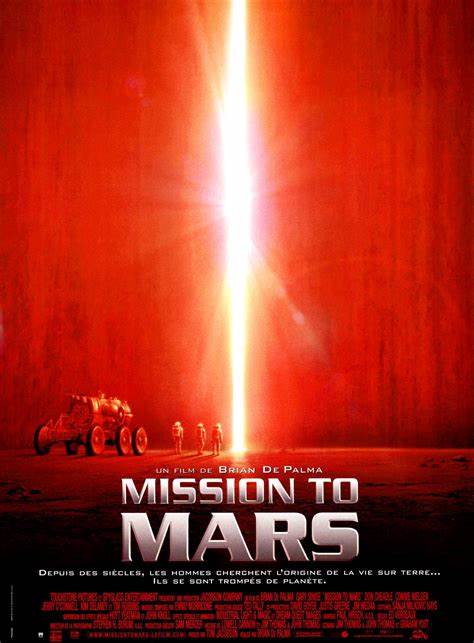As a space enthusiast and a lover of science fiction films, I was excited to watch Mission to Mars, directed by Brian De Palma. Released in 2000, this film promised to deliver a thrilling adventure set against the backdrop of our neighboring planet. In this review, I will delve into the plot, characters, visual effects, and overall impact of the film. I’ll also share my personal insights and opinions on whether “Mission to Mars” lives up to its ambitious premise.
Plot Overview
Mission to Mars is set in the year 2020, where Earth has made significant advancements in space exploration. The film begins with a crew embarking on a mission to Mars, tasked with investigating a mysterious distress signal sent from a previous mission. As I watched, I found myself captivated by the storyline, which weaves together themes of exploration, discovery, and the quest for knowledge about our universe.
The Crew
The crew of the Mars mission includes some notable characters, such as Commander Luke Graham (played by Don Cheadle), who is the mission leader. Other key characters include Jim McConnell (Gary Sinise), a mission specialist, and Terri Fisher (Connie Nielsen), a biologist. The dynamics between the crew members added depth to the narrative, showcasing their camaraderie and challenges. The character development is crucial, as it allows the audience to connect with them on a personal level.
Visual Effects and Cinematography
One of the standout features of Mission to Mars is its visual effects. The cinematography, led by director of photography Haskell Wexler, is nothing short of breathtaking. The depiction of Mars, with its vast landscapes and striking colors, truly immerses the viewer in this alien environment.
I found the use of practical effects alongside CGI to be effective, creating a sense of realism that is often hard to achieve in space films. The Martian atmosphere was portrayed beautifully, making me feel as though I was part of the journey. It is essential to acknowledge the efforts of the visual effects team, who worked tirelessly to bring this extraterrestrial world to life.
Themes and Messages
Mission to Mars explores several themes that resonate deeply with audiences. One prominent theme is the spirit of human exploration and our desire to push the boundaries of what is known. Throughout the film, I felt a strong sense of curiosity and adventure, as the characters ventured into the unknown.
Another significant theme is the concept of connection—both among the crew members and with potential extraterrestrial life. The film raises thought-provoking questions about our place in the universe and the possibility of life beyond Earth. This theme is especially relevant as we continue to learn more about Mars and other celestial bodies.
Acting Performances
The performances of the cast are commendable. Gary Sinise delivers a powerful portrayal of Jim McConnell, capturing the character’s determination and vulnerability. Don Cheadle, as Luke Graham, brings a sense of leadership and responsibility to his role. Connie Nielsen’s performance as Terri Fisher is equally compelling, showcasing her character’s intelligence and bravery.
I appreciated the chemistry among the cast members, which added authenticity to their interactions. The emotional moments, particularly those involving loss and sacrifice, felt genuine and impactful.
Critique and Reception
Despite its many strengths, Mission to Mars was met with mixed reviews upon its release. Some critics praised its ambition and visual spectacle, while others found fault with its pacing and character development. Personally, I felt that the film’s slower moments allowed for deeper character exploration, but I understand why some viewers may have found it dragging.
The film’s climax, which involves elements of science fiction and spirituality, sparked debate among audiences. While I found it to be a bold narrative choice, I can see how it might not resonate with everyone. The blend of hard science fiction with metaphysical elements is a gamble that not all viewers may appreciate.
Soundtrack and Score
The musical score by Ennio Morricone is another highlight of Mission to Mars. The music effectively enhances the emotional undertones of the film, creating a sense of wonder and tension. I found myself deeply moved during key scenes, thanks to the powerful score that accompanied them.
The sound design also plays a crucial role in immersing the audience in the Martian experience. From the silence of space to the sounds of the spacecraft, every auditory detail contributes to the film’s atmosphere.
Conclusion
In conclusion, Mission to Mars is a visually stunning film that offers a blend of adventure, exploration, and philosophical inquiry. While it may not be without its flaws, the strengths of the film—such as its compelling visuals, solid performances, and thought-provoking themes—make it worth watching, especially for fans of science fiction.
Whether you’re a space lover like me or simply looking for a captivating film to enjoy, Mission to Mars provides an engaging experience that invites viewers to ponder the mysteries of our universe.
Watch the Trailer
If you’re curious to catch a glimpse of what Mission to Mars has to offer, I recommend watching the trailer here. This short preview captures the essence of the film and its thrilling adventure.
Further Reading
For more insights into space exploration and related films, check out these articles:
I hope you find this review helpful as you consider whether to embark on this cinematic journey to Mars!
<iframe width="560" height="315" src="https://www.youtube.com/embed/UccsxuP8Tk8?si=R79E2OIbElODFNAM" title="YouTube video player" frameborder="0" allow="accelerometer; autoplay; clipboard-write; encrypted-media; gyroscope; picture-in-picture; web-share" referrerpolicy="strict-origin-when-cross-origin" allowfullscreen></iframe>




.jpg?w=100&resize=100,70&ssl=1)
